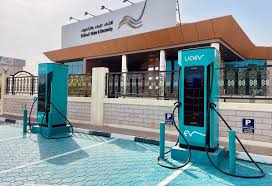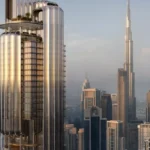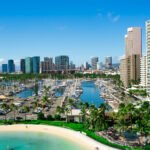Now Reading: Dubai Real Estate: 6 Critical Impacts of EV Charging Tariffs in 2025
-
01
Dubai Real Estate: 6 Critical Impacts of EV Charging Tariffs in 2025
Dubai Real Estate: 6 Critical Impacts of EV Charging Tariffs in 2025

Table of Contents
Dubai’s real estate market, a beacon for U.S. investors with 6-8% rental yields and no capital gains tax, faces a dynamic shift in 2025 amid a projected 15% price decline per Fitch Ratings. The introduction of electric vehicle (EV) charging tariffs by UAEV, the UAE’s first government-owned charging network, effective January 1, 2025, marks a pivotal change.
Set at AED 1.2/kWh + VAT for DC (fast) chargers and AED 0.7/kWh + VAT for AC (slow) chargers, these tariffs end a period of free charging initiated in May 2024. With Dubai aiming for 1,000 Green Charging Stations by 2025 (up 170% from 370 in 2023) and 42,000 EVs by 2030, per DEWA, these tariffs impact the AED 761 billion real estate sector.
This guide, crafted in clear, SEO-friendly language with an engaging tone, outlines six critical impacts of the 2025 EV charging tariffs on Dubai’s real estate market, tailored for U.S. investors, with data-driven insights, legal considerations, and risk analysis.
6 Critical Impacts of EV Charging Tariffs in 2025

1. Increased Operating Costs for Residential Properties
The new tariffs (AED 1.2/kWh + VAT for DC, AED 0.7/kWh + VAT for AC) raise costs for residential buildings offering EV charging, particularly in high-density areas like Dubai Marina. A 40 kWh charge costs AED 50.40 (DC) or AED 29.40 (AC), adding AED 200-400 monthly for frequent users, per UAEV data.
- Impact: Property managers may increase service charges by AED 1-2/sq. ft. annually, reducing net yields by 0.2-0.3% for a AED 1.2 million Dubai Marina apartment yielding 8%.
- Example: A Dubai Marina building with 50 EV users raises service charges by AED 2,400/year, cutting USD 653 from USD 26,149 rental income.
2. Boosted Demand for EV-Ready Properties
The tariffs, coupled with 25,929 EVs in Dubai by 2023 (up from 15,100 in 2022), drive demand for properties with EV chargers, especially in JVC and Dubai Hills, where green features add 5-7% rental premiums, per Knight Frank.
- Impact: EV-ready properties see 10% higher demand, supporting 6-8% yields despite the 15% price decline, per Betterhomes.
- Investor Action: Retrofit JVC apartments (from AED 600,000) with chargers for AED 15,000, recovering costs in 2-3 years via AED 5,000-7,000 rent increases.
- Example: A AED 600,000 JVC unit’s rent rises from AED 42,000 to AED 47,000, adding USD 1,361 to USD 11,431 income.
3. Enhanced Value of Commercial Real Estate

Commercial properties in Business Bay with EV chargers attract eco-conscious tenants, with 30% of UAE residents considering EVs in 2024, per YoCharge. Tariffs ensure cost transparency, encouraging charger installations.
- Impact: Commercial rents rise by 3-5%, boosting 6-7% yields, as businesses leverage chargers for ESG compliance, per Cushman & Wakefield.
- Investor Action: Install DC chargers (AED 50,000-100,000) in Business Bay offices (from AED 1 million) to attract tenants, recovering costs in 3-4 years.
- Example: A Business Bay office’s rent increases from AED 100,000 to AED 105,000, adding USD 1,361 to USD 19,609 income.
4. Pressure on Mid-Tier Market Yields
In oversupplied mid-tier areas like Dubai South, where 72,365 units were delivered in 2025, tenants may resist absorbing charging costs, forcing landlords to maintain rents, reducing yields by 0.3-0.5%, per ValuStrat.
- Impact: Vacancy rates may rise by 2-3% as tenants seek properties with free charging, per CBRE.
- Investor Action: Offer utilities-inclusive leases in Dubai South (from AED 800,000) to maintain 6-7% yields, for pricing insights.
- Example: A Dubai South landlord absorbs AED 200/month charging costs, keeping rent at AED 56,000 to secure tenants, maintaining USD 15,258 income.
5. Support for Infrastructure and Urban Growth
Tariff revenue funds UAEV’s goal of 1,000 charging stations by 2030, supporting Dubai’s 2040 Urban Master Plan for a 5.6 million population, per Dubai Statistics Centre. This enhances connectivity in emerging areas like Azizi Venice.
- Impact: Infrastructure growth drives 10-15% appreciation in Dubai South by 2028, sustaining 6-7% yields, per Emaar Properties.
- Investor Action: Invest in off-plan Azizi Venice units (from AED 800,000) for long-term gains, leveraging 50% payment plans.
- Example: A AED 900,000 Azizi Venice unit appreciates to AED 1.035 million by 2028, yielding USD 36,754 profit.
6. Alignment with Dubai’s Clean Energy Goals
The tariffs align with the Dubai Clean Energy Strategy 2050, aiming for 75% clean energy by 2050, and the Green Mobility Strategy 2030, targeting 10% EV sales by 2030. DEWA’s 236,700-tonne carbon reduction by 2023 underscores progress.
- Impact: Properties in eco-focused communities like Dubai Sustainable City see 5-10% rent increases, enhancing 7-8% yields, per DAMAC Properties.
- Investor Action: Target sustainable properties in Dubai Sustainable City (from AED 1.5 million) for stable returns and Golden Visa eligibility at AED 2 million.
- Example: A AED 1.5 million Sustainable City unit’s rent rises from AED 105,000 to AED 113,000, adding USD 2,178 to USD 28,600 income.
Legal Considerations for U.S. Expats
- UAE Tax Framework:
- VAT: 5% on EV charging tariffs (e.g., AED 0.06/kWh for DC, AED 0.035/kWh for AC) and commercial transactions. Residential rentals are exempt. Recoverable for VAT-registered businesses.
- Corporate Tax: 9% on taxable income above AED 375,000, with 0% for Qualifying Free Zone Persons (QFZPs) or Small Business Relief (revenue below AED 3 million). Residential rental income is exempt.
- Compliance: Register for VAT if taxable supplies exceed AED 375,000 by March 31, 2025. File corporate tax returns by September 30, 2025, for 2024. Penalties: AED 10,000 for late registration, AED 50,000 for missing records.
- U.S. Tax Framework:
- Reporting: Declare worldwide income under FATCA via Forms 8858, 1116, and Schedule E. Income taxed at 10-37%, capital gains at 0-20%.
- Foreign Tax Credit (FTC): Offset U.S. tax with UAE corporate tax paid (not VAT or tariffs).
- FEIE: Exclude USD 130,000 of earned income if resident in UAE for 330 days.
- Freehold Ownership: U.S. investors can own properties in freehold zones (e.g., Dubai Marina, JVC), registered with DLD.
- Golden Visa: Properties worth AED 2 million qualify for a 10-year visa.
- Transaction Fees: 4% DLD fee (split with seller), 2% agency fee, AED 540-4,200 registration fees.
Risks and Mitigation
- Oversupply: 210,000–250,000 units by 2026 may deepen price declines. Invest in EV-ready properties in Dubai Marina for 8-10% yields.
- Tenant Resistance: Mid-tier tenants may balk at charging costs. Offer free AC charging in Dubai South to maintain occupancy.
- Compliance Costs: VAT errors on tariffs risk AED 5,000-50,000 fines. for compliance.
- U.S. Tax Burden: IRS reporting reduces returns. Claim deductions on Schedule E, consulting U.S. tax advisors.
- Infrastructure Lag: Charger rollout may not meet demand. Monitor UAEV’s 1,000-station target.
Step-by-Step Guide for U.S. Investors
- Assess Tariff Impact: Calculate charging costs (AED 29.40-50.40/charge) for properties in JVC or Dubai Marina using DEWA data.
- Invest in EV-Ready Units: Purchase EV-equipped properties in Dubai Hills (from AED 1.2 million) for 6-8% yields.
- Install Chargers: Retrofit with AC chargers (AED 10,000-15,000) to boost rents by 5-7%, recovering costs in 2-3 years.
- Ensure Compliance: Register for VAT by March 31, 2025, if commercial supplies exceed AED 375,000. File U.S. taxes by April 30, 2025, with FTC.
- Target Emerging Areas: Invest in off-plan Dubai South units (from AED 800,000) for 10-15% appreciation by 2028.
- Track Returns: Aim for 6-10% yields and 10-15% gains by 2028, reinvesting savings into sustainable properties.
Conclusion
The 2025 EV charging tariffs, at AED 1.2/kWh + VAT (DC) and AED 0.7/kWh + VAT (AC), reshape Dubai’s real estate market by increasing costs, boosting demand for EV-ready properties, and supporting infrastructure growth. Despite a 15% price decline forecast, U.S. investors can secure 6-10% yields and 10-15% appreciation by 2028 by targeting prime areas like Dubai Marina and sustainable communities like Dubai Sustainable City. Navigating risks like oversupply and compliance costs with advisors. watch more
read more: Dubai: 7 Inspiring Effects of Plastic Ban in 2025



















